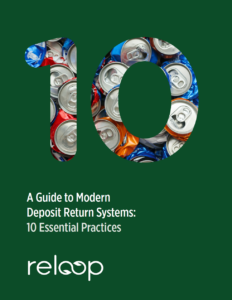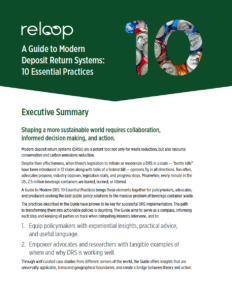
Why Infrastructure Is a Must
Redemption, the podcast designed to save DRS, this week starts to examine the final four practices in the area of Operations —the functions that help maintain a deposit return system over time.
Following our roadmap — A Guide to Modern Deposit Return Systems: 10 Essential Practices, — Episode 8 is all about Practice 7: Infrastructure for Large-Volume Returns.
“One size fits all” definitely does not apply when it comes to designing and running a DRS. Just think about 1) the diverse range of users, 2) their specific and quite different redemption patterns, and 3) the variance in the volume of containers they redeem at return points:
- Consumers return a relatively small number of containers to retailers (low volume)
- Canners collect containers from many places but return to one spot (often high volume)
- Food service businesses generate a significant volume of beverage containers consumed on their premises and routinely return large quantities of containers (very-high volume)
- Bag drop systems allow users to collect their containers in bags and deposit them into designated machines or drop-off points (relatively high volume)
In each scenario, user needs vary significantly. We know from Reloop’s 10 High-Performance Principles (Principle 1: Easy & Equitable) that collection points must be user-friendly so returning a beverage container becomes a part of everyday life. To maintain ease of use, not to mention system effectiveness, integrity, and transparent tracking of materials and funds, a modern DRS must include specific requirements for high-volume redemption.
To understand what this infrastructure looks like and how it operates in real-life, Redemption talked with:
- Normand Bisson, President & CEO of the Quebec Beverage Container Recycling Association
- Ryan Castelia, Executive Director of Sure We Can Education Centre, New York State’s only nonprofit redemption center
Subscribe and tune in to Redemption on Apple Podcasts, Spotify, Google Podcasts, and Amazon Music.
Related resources
-

A Guide to Modern Deposit Return Systems: 10 Essential Practices
10 key requirements for successful implementation of a DRS to serve as a roadmap for policymakers, advocates, and producers seeking the best public policy solutions.
-

A Guide to Modern Deposit Return Systems: 10 Essential Practices Executive Summary
Short summary of the 10 key requirements for successful implementation of a DRS to serve as a roadmap for policymakers, advocates, and producers seeking the best public policy solutions.